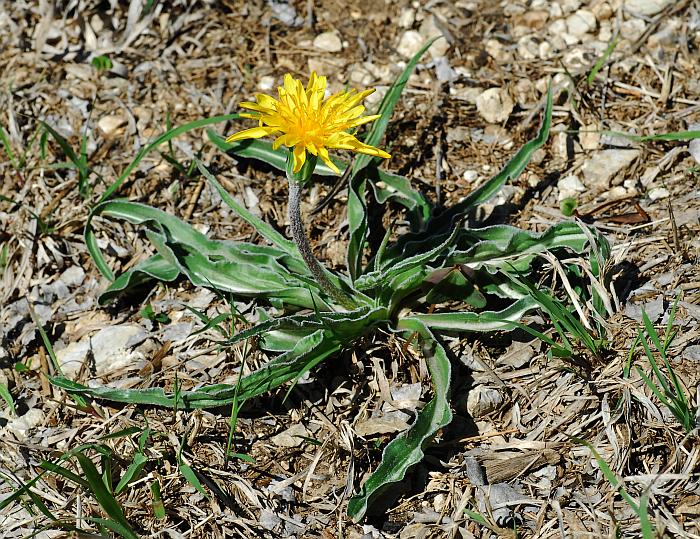Nothocalais cuspidata (Pursh) Greene
Prairie Dandelion

Native
CC = 10
CW = 5
MOC = 5
SRank = S2
© SRTurner
Nothocalais cuspidata (Pursh) GreenePrairie Dandelion | |
 |
Native CC = 10 CW = 5 MOC = 5 SRank = S2 |
© SRTurner |
|
Family - Asteraceae/Cichorieae Habit - Perennial forb with milky latex and a fleshy and somewhat woody and hardened taproot. Stems - Absent. Leaves - Leaves in a basal rosette, sessile, linear-attenuate, white at the partially sheathing base, mainly dark green with an adaxial white strip along the midrib, to 35 cm long, 1.5 cm broad at the base, typically folded. Margins entire, undulate, fringed with dense white hairs. Abaxial surface of the leaf with long whitish pubescence on the veins. Adaxial surface woolly-pubescent on the midvein.
Inflorescence - Solitary terminal heads, typically one per plant. Scapes to 15cm tall, densely woolly, appearing gray because of the pubescence.
Heads - Heads to 5 cm broad. Involucre 13-27 mm long at flowering, only slightly elongating at fruiting, cup-shaped to bell-shaped, the bracts 13-35, in usually 2 subequal but overlapping series, narrowly lanceolate to lanceolate, mostly long-tapered to a sharply pointed tip, glabrous or minutely hairy toward the tip, green with narrow to broad, thin, pale margins, sometimes purplish-spotted or with a faint purple midvein. Receptacle naked, shallowly pitted at the base of each floret.
Florets - Disk florets absent. Ligulate florets 35-80. Corollas 15-27 mm long, bright yellow, often somewhat grayish or purplish tinged on the outer surface. Ligule 4-5-notched at the apex, pubescent abaxially, glabrous adaxially, to 2cm long, 5mm broad. Pappus 8-11 mm long, of numerous bristles, these minutely barbed, white, grading into varying numbers (often numerous) of very narrow, awnlike scales similar to and difficult to distinguish from the bristles. Stamens 5, adnate near the apex of the corolla tube. Filaments translucent-yellow, 2 mm long, glabrous. Anthers orange, exserted, to 5 mm long. Style yellow, antrorsely pubescent, bifurcate at the apex for 1-2 mm.
Fruits - Fruits 7-10 mm long, narrowly cylindrical (tapered slightly at the base), not flattened, 10-ribbed, not beaked, not expanded at the tip, the surface minutely roughened, otherwise glabrous, yellowish brown to brown.
Flowering - April - June. Habitat - Glades and rocky prairies. Origin - Native to U.S. Lookalikes - The common dandelion has very similar flowering heads, but the leaves are totally different. Other info. - This plant is very uncommon in Missouri, only being found in 5 counties thus far. It is locally abundant in some areas, however. It is much more common in states to our north and west, ranging into western Montana and also Canada. The plant is easy to identify in the field because of its habitat, dandelion-like flower heads, and grayish hairy leaves and scapes. The big taproot helps the plant to survive in its harsh glade habitat. Photographs taken at Danville Conservation Area, Montgomery County, MO., 4-17-04 (DETenaglia); also at Danville Conservation Area, 4-25-2017, 5-5-2018, and 4-20-2019 (SRTurner). |